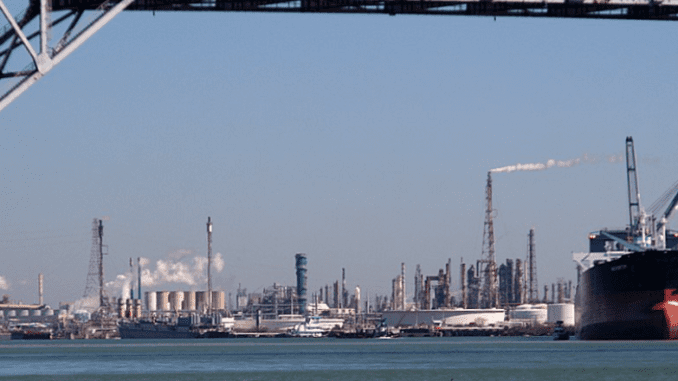
CORPUS CHRISTI, Texas, August 22, 2021 (ENS) – The Port of Corpus Christi Authority and Howard Midstream Energy Partners, LLC have executed an agreement to convert Howard’s Javelina refinery services facility into the region’s first blue hydrogen production facility.
Howard’s Javelina facility is positioned in the Port of Corpus Christi with pipeline connectivity to all six of the local refineries. Javelina controls some sixty million cubic feet per day of hydrogen production through a combination of hydrogen entrained in the refineries’ waste gas that the facility processes, and hydrogen produced through a steam methane reformer process.
This hydrogen is currently sold back to refineries and other industries where it is used to remove impurities like sulfur during the refining process.

courtesy HMEP)
The Port of Corpus Christi and Howard ultimately hope to scale hydrogen production for exports to overseas demand centers.
“With this exciting project and progressive partnership with the Port of Corpus Christi, we are demonstrating yet again our commitment to delivering clean, reliable energy that powers communities and business around the world,” said Mike Howard, Howard Midstream Energy Partners chairman and CEO.
.Hydrogen atoms can be separated from water (H2O) or from natural gas (CH4), which is in abundance at the Port of Corpus Christi due to direct connections to the Permian Basin and Eagle Ford Shale production fields.
But while so-called blue hydrogen, which makes hydrogen by extracting it from the methane in natural gas, is being praised as a clean, green energy to help reduce global warming, Cornell and Stanford University researchers believe it may harm the climate more than burning fossil fuels.
According to new research published August 12 in the journal “Energy Science & Engineering,” the carbon footprint to create blue hydrogen is more than 20 percent greater than using either natural gas or coal directly for heat, or about 60 percent greater than using diesel oil for heat.

“Most of the hydrogen in the U.S. and Europe comes from natural gas, using steam and pressure to convert the methane from natural gas into a so-called gray hydrogen and carbon dioxide,” said Robert Howarth, a professor of ecology and environmental biology in the College of Agriculture and Life Sciences at Cornell.
Howarth, together with Mark Jacobson, Stanford professor of civil and environmental engineering, authored “How Green is Blue Hydrogen?”
Green hydrogen is produced through water electrolysis process by employing renewable electricity. The reason it is called green is that there is no CO2 emission during the production process. Water electrolysis is a process which uses electricity to decompose water into hydrogen gas and oxygen.
Blue hydrogen is sourced from fossil fuel. However, the CO2 emitted during production is captured and stored underground in a process called carbon sequestration. As no CO2 is emitted, the blue hydrogen production process is categorised as carbon neutral.
Gray hydrogen is produced from fossil fuel and commonly uses steam methane reforming method. During this process, CO2 is produced and eventually released to the atmosphere.
The parties to this agreement will collaborate to identify uses for the residual carbon dioxide (CO2) as well as capture and storage options. Captured CO2 can be directed to industries that need it for production, such as steel, or that assimilate it, like cement.
The Port of Corpus Christi has committed to developing the infrastructure to collect and pressurize CO2 for injection in permanent geological storage formations offshore in the Gulf of Mexico.
“To the extent that our identity as the leading export gateway for U.S. produced hydrocarbons has been solidified, we see an elegant symmetry in the prospect of becoming the nation’s premier hub for carbon management,” said Chief Strategy and Sustainability Officer for the Port of Corpus Christi Jeff Pollack.
On August 7, the Intergovernmental Panel on Climate Change, IPCC, released an assessment of the physical basis of climate change that calls for immediate, unified and aggressive action if the nations of the world are to avoid the most dire impacts, such as more frequent and intense storms and drought.
The report calls for elimination of all CO2 emissions by 2050 and for the development of infrastructure to capture and permanently store carbon.
“The mandate in the latest IPCC report is clear, and while the energy sector certainly can’t shoulder this responsibility on its own, we must lead by example,” said Sean Strawbridge, CEO for the Port of Corpus Christi. “Our future as the Energy Port of the Americas starts with building a scalable carbon capture and storage solution to serve the needs of our existing customers and convert more Texas gas into carbon neutral hydrogen for the global markets.”
Featured image: Located on the western Gulf of Mexico, the Port of Corpus Christi is the largest port in the United States in total revenue tonnage. January 25, 2007 (Photo by Erin)
© 2021, Environment News Service. All rights reserved. Content may be quoted only with proper attribution and a direct link to the original article. Full reproduction is prohibited.



